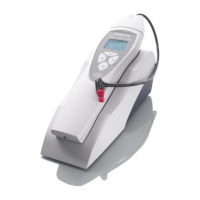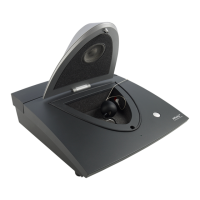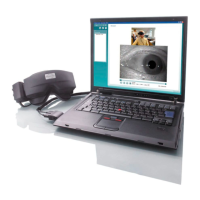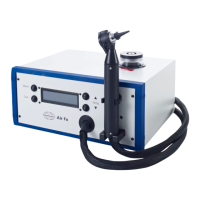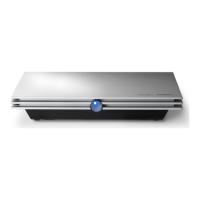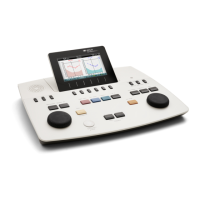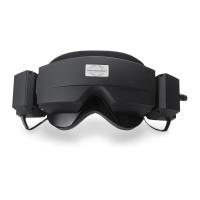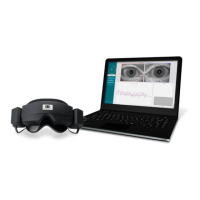
Do you have a question about the Interacoustics Sera and is the answer not in the manual?
| Brand | Interacoustics |
|---|---|
| Model | Sera |
| Category | Medical Equipment |
| Language | English |
Manual validity, manufacturer details, and contact information for the SeraTM device.
Specifies the audiologic applications and target population for the SeraTM device.
Lists conditions where testing is not advised without medical approval.
Details the SeraTM device's capabilities, configurations, and components.
Explains the importance of diagnosing hearing loss in infants for development.
Defines symbols used for warnings, cautions, and notices in the manual.
Provides instructions for handling and reporting product malfunctions.
General safety guidelines for operating electrical equipment and device use.
Important cautions regarding device operation, repair, and accessory use.
Specifies recommended operating and storage conditions for the instrument.
Safety measures related to electrical connections and avoiding leakage current.
Precautions for avoiding electromagnetic field exposure and mutual disturbance.
Warnings about using the device in environments with flammable gases or oxygen.
Notes on the instrument's suitability for home healthcare use with protection.
Emphasizes annual calibration for accuracy and potential warranty voiding.
Important notes on software installation, storage, handling, and disposal.
Guidance on acclimatizing and checking the instrument after transport.
Procedures for checking the received instrument for damage and reporting faults.
Explains various symbols and their meanings found on the instrument.
Instructions on how to connect and place the SeraTM cradle for charging.
Guidance on connecting and pairing the optional wireless label printer.
Details on how to charge the printer's battery using various connection methods.
Step-by-step instructions for loading label rolls into the printer.
How to power the printer on, off, and manage standby mode.
Instructions for pairing the HM-E200 printer with the SeraTM device.
Explains the error message when the printer is not found or out of range.
Identifies and describes the main hardware components of the SeraTM handheld unit.
Details the two methods for connecting the SnapPROBETM probe to the device.
Instructions for connecting transducers via the preamplifier cable.
How to securely connect electrode lead cables to the preamplifier.
Describes the two versions of IP30 transducers for ABRIS module use.
Instructions on connecting the ABRIS pass-checker for hardware integrity assessment.
Explains how SeraTM automatically detects transducers and reads calibration data.
Details on powering the instrument using the battery and AC cradle.
Information on the rechargeable Lithium-ion battery and connection for charging.
Precautions for battery maintenance and estimates of charging times.
Explains the meaning of LED indicator light colors on the SeraTM and cradle.
Overview of the HearSIMTM software for device customization and data management.
Information on managing test type licenses for the SeraTM device.
Step-by-step guide to adding new test type licenses via software.
Instructions on how to check and update the device's firmware.
Essential precautions for using the SeraTM device safely and effectively.
Procedures for powering the SeraTM device on, off, and boot-up sequence.
Guidelines on performing tests while the device is charging.
Explains how to interpret the battery status symbols and warnings.
Overview of the SeraTM screen layout and common function buttons.
Details the components of the general SeraTM screen layout.
Explains the icons and functions of common buttons used in the interface.
How to access and use special characters on the on-screen keyboard.
Describes the main screen and its buttons for accessing core functions.
Steps for entering patient demographic information manually.
Explains the process for resolving duplicate patient ID entries.
How to find and select patients from the stored database.
Guidance on patient consent, test procedures, and result interpretation.
Steps for preparing a patient for Automated ABR testing.
Guidance on preparing a patient for OAE testing.
Instructions on using and selecting appropriate disposable ear tips.
Guidance on using EarCups and EARturtle™™ accessories for testing.
Describes the different ways to initiate a test on the device.
How to choose the specific test protocol (TEOAE, DPOAE, ABR) to perform.
Configuring and entering patient-specific test fields.
Explains the symbols used to indicate test results (Pass, Refer, Incomplete).
How to select and record a reason for an incomplete test.
Procedures for printing test results using the label printer.
Overview of the steps and screens involved in Automated ABR testing.
Details the initial screen and components for Automated ABR testing.
Explains the impedance check process and feedback indicators.
Describes the measurement screen, progress bars, and noise indicators.
How the noise bar indicates EEG quality and acceptable signal levels.
Explains the progress of the time bar during the measurement.
Details the screen shown after completing an Automated ABR test.
Overview of the steps and screens involved in OAE testing.
Details the initial screen and components for OAE testing.
Explains the probe fit check process for DPOAE and TEOAE.
Describes the OAE measurement screen with progress bars and stability indicators.
How the probe stability bar indicates fit quality during OAE testing.
How the noise bar indicates acoustic noise levels during OAE testing.
Explains the progress of the time bar during OAE measurements.
Details the screen shown after completing an OAE test.
Instructions for performing and saving quick tests without patient data entry.
Overview of the Quick Test function and its limitations.
Steps to save a Quick Test session to a specific patient.
Information on how to print test results from the device.
Describes how to access printing functions from different screens.
Details the information included on the printed labels.
Steps for managing patient data, viewing test history, and printing sessions.
How to view and sort the list of patients stored on the device.
Instructions on using the search function to find patients.
How to proceed with testing a selected patient.
How to access a list of previously performed tests for a patient.
Steps to select and print individual saved tests.
How to view detailed test results and associated field information.
Information on setting up and managing user logins for the SeraTM device.
Overview of user login functionality, which is disabled by default.
Steps for selecting a user from the list after login is enabled.
How to enter the user password to access the device.
Explains the message displayed for incorrect password entries.
Accessing and configuring device settings directly on the SeraTM.
How to select the preferred language for the device interface.
Setting preferences for power save, power off, display brightness, and time/date.
Configuring sound feedback for button presses, test end, and warnings.
Steps for pairing the HM-E200 wireless printer with the SeraTM.
Viewing device information such as version, serial numbers, and licenses.
Recommends daily equipment checks to ensure proper functioning of probes and cables.
How to use the optional Pass-Checker accessory for ABR integrity checks.
Procedure for testing probe integrity for TEOAE using the Infant Ear Simulator.
Procedure for testing probe integrity for DPOAE using the Infant Ear Simulator.
Recommendations for maintaining instrument performance and safety, including annual service.
Safety precautions and recommended solutions for cleaning the instrument.
Instructions for cleaning the touch screen, case, cradle, and cables.
How to clean the SeraTM touch screen using a lint-free cloth.
Guidance on cleaning and disinfecting the instrument's external parts.
Emphasizes single-use nature of disposables and risk of cross-contamination.
Illustrated instructions for cleaning the OWA probe tip using cleaning floss.
How to access and clean the filters within the SnapPROBETM probe.
Recommends keeping reusable components and replacement parts available.
Conditions under which Interacoustics is responsible for repair and service.
Details the warranty terms and expected service life of the SeraTM instrument.
Comprehensive technical specifications including CE marking, standards, power, and environment.
Details pin descriptions for connectors and USB specifications.
Provides reference SPL values for CE-Chirp stimulus calibration.
Provides reference SPL values for click stimulus calibration.
Specifies the ear simulator coupler types used for calibration.
Notes on product improvement, maintenance, and contact information for inquiries.
Explains the CE-Chirp® stimulus used in some ABR protocols.
Details EMC requirements and guidance for the SeraTM equipment.

